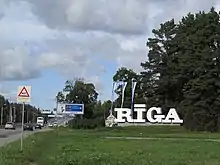Valdis Celms
Valdis Celms (born 24 October 1943) is a Latvian graphic designer, known for his kinetic art[1] and one of the leaders of the neopagan organization Latvijas Dievtuŗu sadraudze.
Valdis Celms | |
|---|---|
| Born | 24 October 1943 |
| Nationality | Latvian |
| Education | Art Academy of Latvia |
| Occupation | Artist, religious leader |
Biography

Celms was educated at the Art Academy of Latvia. He is considered one of the founders of kinetic art in Latvia due to his exploration of the artform in the 1960s. He became prominent in the Latvian artworld in the 1970s with his kinetic art, photomontages and graphic design.[2][3] In 1980 he designed the large "Rīga" signs that welcome people as they enter the Latvian capital through its main roads.[4]
In 2007 he published the book Latvju raksts un zīmes ("Latvian Patterns and Symbols") which went on to sell well. In 2016 he published Baltu dievestības pamati ("Fundamentals of the Baltic Religion"), where he, influenced by Ernests Brastiņš, Marija Gimbutas and Janīna Kursīte-Pakule, gives an introduction to the Baltic deities and how to be aware of them.[5] He is one of the leaders of the Baltic neopagan group Latvijas Dievtuŗu sadraudze. In this capacity he led the team that created the Lokstene Shrine of Dievturi on an island in the Daugava river, inaugurated in 2017.[6]
A large retrospective of his artworks was held at the Museum of Decorative Arts and Design in 2013 to celebrate his 70th birthday.[7] In 2014 he was awarded the Order of the Three Stars from the Latvian state.[8]
References
- Celms, Valdis (1994). "The Dialectic of Motion and Stasis in Kinetic Art". Leonardo. The MIT Press. 27 (5, Prometheus: Art, Science and Technology in the Former Soviet Union: Special Issue): 387–390. doi:10.2307/1576092.
- Rušeniece, Līga (14 November 2016). "Valdis Celms: Būt latvietim ir garīgs uzdevums". Neatkarīgā Rīta Avīze (in Latvian). Retrieved 9 May 2020.
- "Dizainera Valda Celma izstāde Pieskārieni". Diena (in Latvian). 11 March 2013. Retrieved 9 May 2020.
- Adamaite, Undīne (29 July 2009). "«R», «Ī», «G», «A»". Diena (in Latvian). Retrieved 9 May 2020.
- "Iznākusi Valda Celma grāmata par baltu dievībām". Latvijas Sabiedriskais medijs (in Latvian). 15 December 2016. Retrieved 9 May 2020.
- "Uz salas Daugavā atklāta dievturu svētnīca". Skaties (in Latvian). 11 May 2017. Retrieved 9 May 2020.
- "Kustības krāsa". Diena (in Latvian). 26 March 2013. Retrieved 9 May 2020.
- "Deju lieluzveduma Tēvu laipas veidotāji saņems Valsts augstākos apbalvojumus". Diena (in Latvian). 24 April 2014. Retrieved 9 May 2020.